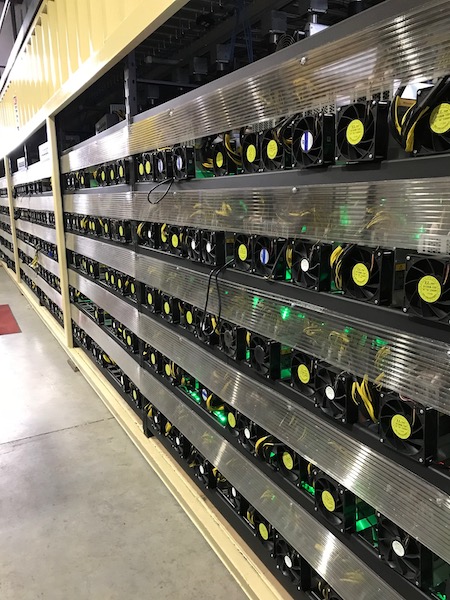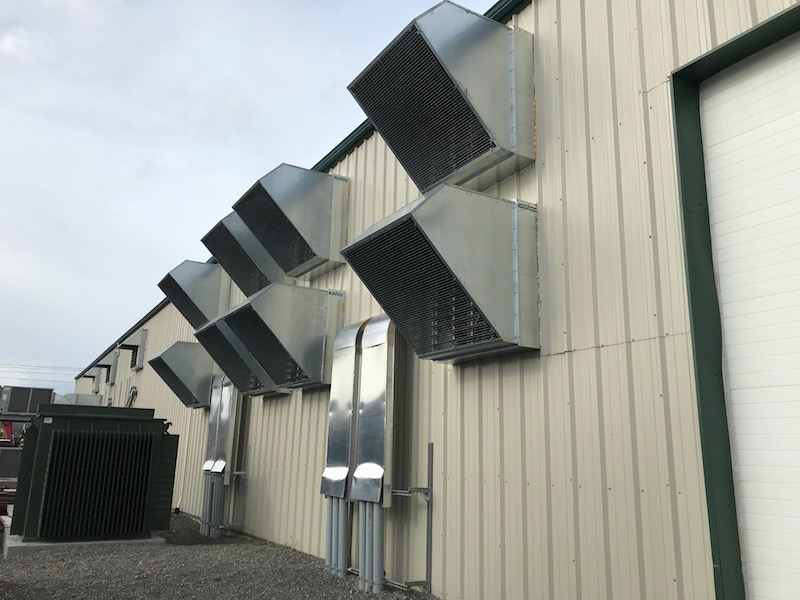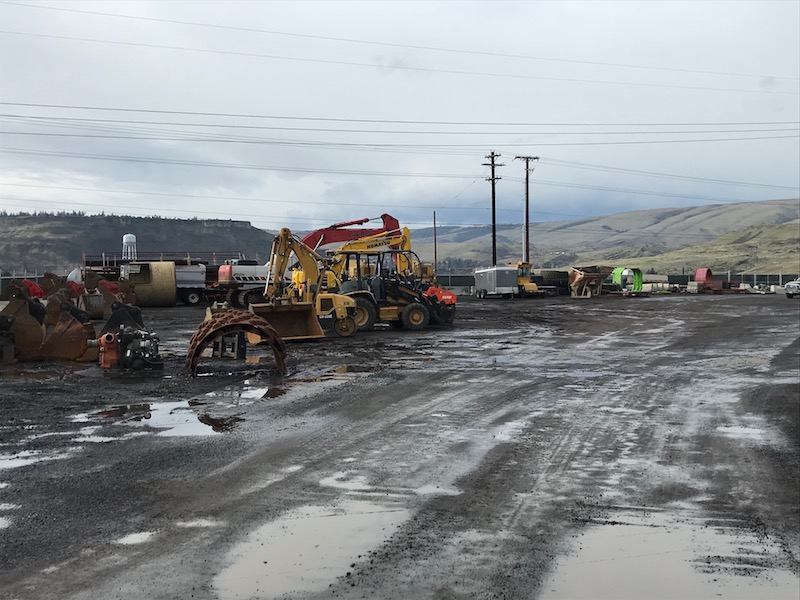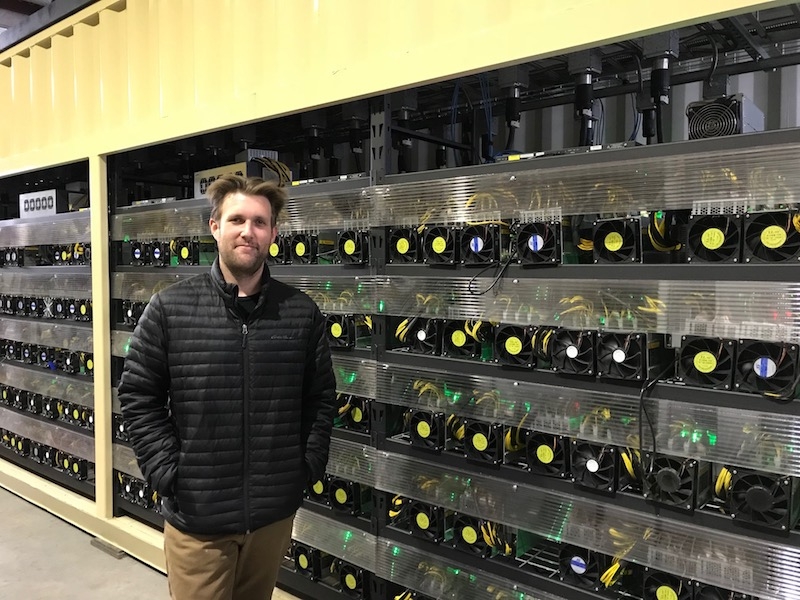A bitcoin miner gives us a tour of his Columbia Gorge facility.
It is an unseasonably mild winter day in The Dalles, but I am compelled to button up my coat when I enter a chilly, climate-controlled facility housing rows upon rows of computers mining bitcoin, the cryptocurrency.
The constant whirr of fans prevents the machines, around 2,750 of them, from overheating. The computers run 24/7 solving complex math problems that generate the cryptocurrency.
Terrence Thurber, a 33-year-old bitcoin miner from southern California, is giving me a tour of the facility he opened in 2014. His company, OregonMines, hosts and maintains machines that mine cryptocurrency for around 100 clients from the U.S. and abroad.
OregonMines is one of a handful of so-called co-location hosts for cryptocurrency mining that have popped up in the Pacific Northwest over the past couple of years.
RELATED STORY: BITCOIN ATM RETURNS TO PIONEER PLACE
The sensational rise in value of bitcoin last year, which increased to a high of around $19,000 in December 2017 from $1,000 at the start of the year, is grabbing everyone’s attention, and has led to an influx of demand for hosts that maintain and service the computers that mine the virtual currency.
The sector has a whiff of a modern-day Gold Rush.
“It is like 1849,” said Thurber, referring to the height of the California Gold Rush when thousands of miners traveled to the state to mine for newly discovered gold.
The Pacific Northwest is a popular location for bitcoin miners because it has an abundance of hydropower, which means it has some of the cheapest electricity rates in the nation.
Mining bitcoin is energy-intensive because it requires a lot of computational power to solve the math puzzles that generate the cryptocurrency, which get more complex over time.
Despite the cooling systems in Thurber’s facility, up close I feel heat coming off the machines as they work to solve the math problems.
The competitive nature of bitcoin mining gives the sector an air of secrecy and opacity. Bitcoin miners compete with countless others around the world to be the first to solve the math puzzles that result in the generation of bitcoin for the winner.
“You need to be opaque,” said Thurber. “People are trying to get advantages over what you are doing.”
Secrecy shrouds the sector and it shows at OregonMines, which is located on an industrial park on the outskirts of The Dalles in a nondescript office building. A small sign above the door to its main facility is the only indication of its physical presence.
Thurber seeks to differentiate his business from other mining operations by focusing on customer service. He says he knows several private bitcoin mining operations, but only a handful in the area are doing what he is doing – providing hosting services to outside clients. Around half his customers are private individuals and groups. The other half are financial institutions.

Cryptocurrency machines inside OregonMines
Thurber started mining bitcoin in 2013 when he was living in Costa Rica. He had down time one month from his job in internet marketing and found a site where he started to mine. “I was enamored by it. It was so easy to engage with,” he said.
His hosting facility was in Shenzhen, China, where most bitcoin mining takes place. Having a host so far away created hurdles because of the time zone difference. Customer service was also an afterthought, he said.
Frustrated with options in the space, Thurber decided he could save money by creating his own hosting service. In May 2014, he broke ground on The Dalles facility.
The low cost of power was key to his decision to locate in The Dalles, Oregon’s largest city along the Columbia River outside of the Portland metropolitan area. The Northern Wasco County Public Utility District, which provides electricity to residents and businesses in The Dalles and surrounding area, has some of the lowest electricity rates in the state. The utility operates two hydroelectric dams on the Columbia River, which provide most of its electricity needs.
Thurber likes the dry climate, which is good for the facility’s cooling systems. Located an hour-and-a-half drive from Portland, it is also relatively close to a major metropolitan area. “I felt clients wouldn’t mind driving the 70 miles from Portland,” he said.
RELATED STORY: IS OREGON THE NEXT FRONTIER FOR BITCOIN MINERS?
Cheap electricity costs has also attracted other tech companies to the area, creating a budding tech scene. Google located its first data center in The Dalles in 2006. The huge complex is practically next door to OregonMines. And the technology giant is growing. Google plans to expand on land that surrounds Thurber’s facility.
OregonMines has the look and feel of a start-up in a rapid growth phase. The company just expanded into a new office across the parking lot from its main facility. It is developing an annex to its main building that will hold additional machines for mining cryptocurrency. The new office is still bare, with little furniture. The CEO goes off to find a chair for me to sit on.

A cooling system keeps bitcoin machines from overheating
OregonMines’s first client, a private individual, came onboard in 2014 before the company even had a website. It saw steady growth over the next three years with large institutional customers getting involved in 2016.
Last year was the biggest growth spurt for OregonMines. The run-up in bitcoin value in 2017 generated a flood of interest in the company’s services. It originally had a telephone number on its website, but Thurber told me he took it down to be able to deal better with inquiries. Interested participants fill out an online form to make first contact.
“The amount of demand we have had is sensational,” said Thurber.
The CEO expects even more growth in clients in 2018. The company employs around 15 full-time staff, but he envisions 20 to 25 people working for him eventually. The company makes approximately $3 million in revenues.
The growth of the business means the company is maxing out on capacity at The Dalles facility. Thurber is opening a center across the border in Washington state within 30 miles of the main office to accommodate the company’s growth.
He would like to expand in The Dalles, but thinks he will not get much more power from the local utility. The facility uses on average 2.5MWh to power its constantly running machines. The facility has capacity to use 3MW, enough electricity to power (roughly) 3,000 homes.
Google’s expansion of its data center in The Dalles will likely constrict any large-scale growth plans for OregonMines, and could limit the number of other colocation mining hosts interested in setting up in the area.

Google is expanding on land surrounding the bitcoin mining facility
In a document outlining an agenda for a utility meeting scheduled for February 6, the electricity provider said load levels at the Google facility are increasing, and that construction of new transmission is necessary to serve the data center in early 2018.
“There is not a finite amount of power here. The consumer demand is huge but you need to build transmission lines, and there are only so many lines,” said Thurber.
The local utility received around 10 applications for power service from bitcoin mining operations in November last year, an engineer for the utility told me in December.
The uptick in interest coincided with a surge in the value of the cryptocurrency, which reached almost $10,000 by the end of the November from $6,750 at the start of the month, according to Coindesk, a website that tracks the value of bitcoin.
The utility district is carefully studying the potential electricity needs of bitcoin miners. It is talking to an outside engineering firm to help it evaluate the cryptocurrency requests for capacity.
RELATED STORY: THE OREGON BUSINESS BROADCAST: WHAT IN THE WORLD IS BLOCKCHAIN?
Bitcoin miners have caught other utilities off caught guard by how much power they use, leading to some stigma of the sector.
In Chelan County in eastern Washington, several small cryptocurrency server farms placed large, energy intensive load of the network that overloaded transformers and transmission.
They were also highly mobile, moving in and out of the district, making little infrastructure investments and causing unpredictable fluctuations in electricity use.
Thurber concedes bitcoin mining operations can be put pressure on the electricity system because power demand is constant. “It took PUDs time to realize power demand is continuous. A lot of data centers – power demand goes up and down. Bitcoin is 24/7 – power usage is the same every day. It can be taxing on the system.”
The recent drop in bitcoin’s value hasn’t yet affected demand for his company’s services, said Thurber. Bitcoin’s value has fallen by more than half from its peak in December.
The recent decline followed several bad news items associated with the virtual currency, including Facebook’s announcement at the end of January that it would no longer allow ads promoting cryptocurrency as part of a policy to prevent services that have “misleading or deceptive promotional practices.”
Despite the virtual currency’s volatility, it continues to attract users, keeping demand for hosting services strong, said Thurber. “A lot of new money is speculative. There are few markets where you can easily make a position and get out.
“You can get involved and nobody will stop you. You don’t see that in the banking world.”





